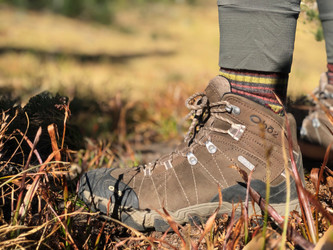How to Break in Hiking Boots
Posted by AJ ElChaar on Wed Apr 6th 2022
You just picked up a great-fitting new pair of hiking or backpacking boots. You tried on several styles and sizes in the store until you found the one that was just right. Next step, hit the trail… Well, sort of. If you have a brand new pair of boots, no matter how comfortable they feel right out of the box, taking them on a big adventure without proper break in can be a recipe for disaster and discomfort.
The Importance of Break-In
Brand new boots might feel pretty good in the store. They might even feel pretty good the first hour or so that you wear them outside. But the reality is that even if they were custom made for your feet, they still won’t be a perfect match for your foot in motion. New boots in many cases, are bound to rub in certain areas, create pressure in others, etc – especially after several hours of wearing them. Sometimes it can be downright painful to the point that you question if there is a defect or problem with the boot itself. By gradually breaking in a pair of boots over time, you will avoid many of these issues and soon move on to all day wear with comfort.
General Break In Process
The general break in process is pretty simple. Wear your boots for short durations at first, gradually increasing the amount of time / miles you spend in them. Exactly what that looks like can vary depending on the type of boot. For example, a very flexible day hiking boot might only need a mile or two of wear before it’s broken in enough to be comfortable – essentially “no break in.” On the other hand, a stiffer backpacking or mountaineering boot might not be fully broken in until you’ve put in dozens of miles on varied terrain.
There are many ways to break in a pair of boots, but my preferred way to break in boots is pretty simple and it goes more by feel than by a specific time table. It should be easy enough that anyone can do it. Here’s a breakdown of what’s involved:
Step 1: Wear the boots around inside the house for 15 minutes or so just to do one final confirmation that I like the fit.
Step 2: Take a short walk in the neighborhood or on an easy trail, maybe 2 miles at most, then asses how your feet feel. Are any areas bothering me? Should I lace up differently? Could I have walked double the distance comfortably?
Step 3: Keep doing Step 2 until you’re confident with how the boots perform on those short outings.
Step 4: Add in a challenge like carrying a pack, taking on steeper / more challenging terrain, or putting in more miles or hours in the boots. Afterwards, assess. How did everything feel? Are there any problem areas? At this point you’ll not only be breaking in your boots, but you’ll also be breaking in yourself to the boots. For example, that spot that was rubbing your ankle will start to soften up a little, but that part of your ankle will also become accustomed to boot and toughen up or develop a callous.
Step 5: After a few challenges like in Step 4 you should be ready to tackle some all-day wear adventures with your broken in boots!
Alternative approaches
Let’s say, for whatever reason, the method above isn’t going to work for you. There are plenty of other ways to break in boots, but if I were to think about a “second best,” it would be something like this:
Either every morning or every evening, wear your boots around the house for 10 or 15 minutes. Make sure you walk around, flex them, bend at the ankle, etc. Your goal is to press into and really work those areas around the ball of the foot and ankle where discomfort is most common.
On the weekends or when you have to run errands, wear your boots. Ideally this should also involve walking, because if they’re just sitting on your feet, you’re not really doing much to break them in.
After a week or two of doing this, you’ll be ready to pick up with something along the lines of Step 4 above. If that goes well, you’re on your way to having some broken-in boots.
Shortcuts
One “shortcut” I sometimes use on leather boots is getting the leather damp and “walking them dry.” Damp leather is softer and more prone to stretching and molding to your feet. Getting the leather wet can aid in the break in process, provided you wear and walk in them until they are mostly dry. You have to be careful with this shortcut, because if you dry the boots too quickly, like in front of a fire or stove, you could make the boots fit worse or possibly even cause irreparable damage them. One product I use for this kind of damp break in is shoe stretch spray. It doesn’t actually stretch the leather, per se, it just is used to dampen the leather for an easy break in. The difference between shoe stretch spray and water is that shoe stretch is formulated to dry faster so you don’t have to be in your boots as long for an application. This shortcut will not fully break in the boots, but it can help reduce the number of miles you have to put on to achieve the goal.
Other Tips
Get wool socks. The right socks play a huge role in getting good comfort and performance out of your hiking boots. Right now there is no substitute for a quality pair of merino wool socks. Some advanced synthetics do a good job at wicking away sweat and preventing blisters, but they still fall short in other areas compared to merino wool. One more thing about merino – it IS NOT itchy. Over the years I have introduced (and sometimes tricked) many people to wearing wool socks who claimed they absolutely cannot wear wool because it gives them a rash. Merino wool is a much finer and softer thread than standard wool and it will not cause itching, rashes, or blisters on your feet. Cotton socks, on the other hand, will cause all of those problems on prolonged outings and multi-day backpacking trips.
Throw away the stock insoles. Ok, you don’t actually have to throw them out, but a good fitting pair of orthotic insoles will be much more friendly to your feet, ankles, knees, hips, and back. I recommend trading out the stock insoles for a good pair of orthotics on any new pair of boots.
Learn to lace. There are a couple of lacing techniques that are good to know for boot break in and for general comfort on the trail. I won’t go into details here, but look up window lacing and heel lock lacing for hiking boots. Window lacing can be used to relieve pressure from certain areas by skipping eyelets or not crossing laces at certain points on the boot. Lock lacing can help you maintain different levels of pressure and support at different parts of the boot.
There are plenty of ways to break in your boots and they can’t all be covered in this article. The important thing is that you do a thorough break in before attempting that next big adventure. That way, you can focus on enjoying the activity instead of suffering through discomfort in your feet.

